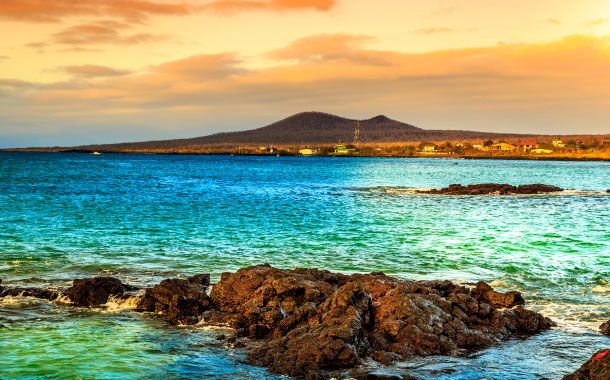Nestled in the Pacific Ocean, the Galápagos Islands are an archipelago of volcanic islands. Part of the Republic of Ecuador, it is home to a rich diversity of plant and animal species that cannot be found elsewhere. UNESCO declared the Galápagos Islands as the first World Heritage Site in 1978. Popular activities on these islands include snorkelling with sea lions and sea turtles.
Charles Darwin, the popular English naturalist and biologist, visited the Galápagos Islands in 1835. He observed the Galápagos' species which inspired his work of scientific literature, ‘
On the Origin of Species’ and the concept of ‘theory of evolution’.
Iguana
It is believed that the Galapagos Iguanas had a common ancestor that floated out to these islands from South America. You’ll find these Iguanas basking on rocks. They are cold-blooded and absorb heat from the sun. To preserve their body heat, they sleep in burrows during the night. Conolophus subcristatus (yellow or brown in colour), Conolophus pallidus (brownish-red in colour) and Conolophus marthae (pinkish) are the three species of land iguana found here.
Frigatebird
Take a look at the red neck sacks of this bird, interesting - isn’t? Well, this is the Frigatebird which belongs to the family of seabirds known as Fregatidae. Of black plumage, these birds have long and deeply forked tails. Due to their habit of stealing food from birds like masked boobies, they are called ‘pirate birds’. The females have white underbellies whereas the males have a red gular pouch. In order to attract females, they inflate these pouches during the breeding season.
Blue Footed Boobies
Sula nebouxii aka blue-footed booby is a marine bird with unique bright blue feet. It feeds on fish which include mackerel, flying fish and sardines. They are exceptional divers who dive underwater to hunt for their prey; they are capable of plunging into the water from as high as 80 feet. During night time, these birds nest on land.
Sally Lightfoot Crab
Sally Lightfoot Crab (Grapsus grapsus) is a fast-moving crab. It is not considered very edible by humans; they are mostly used as bait by fishermen. The young crabs are black or dark brown in colour. They camouflage perfectly on the black lava coasts of the volcanic islands. Adults are brownish-red, yellow, pink or spotted brown in colour.
Giant Pinta Tortoise
The Pinta Island tortoise or the Pinta Giant tortoise is almost extinct. Due to hunting, this species had been wiped out by the 19th century. These giant tortoises were assumed to be extinct, until 1971, when a single male of this species, named Lonesome George, was found on the island. In spite of several efforts made to mate the male with other species, no viable eggs were produced. Later in 2012, 17 first-generation hybrids were discovered on the Isabela Island by Yale University researchers. You can visit the Charles Darwin Research Station to catch a glimpse of tortoises, from unhatched eggs to full-grown adults.
Best time to visit
You can plan your holiday from December to June, the warm and wet season, when the sea is calmer with good underwater visibility.
If you want to spot wildlife, then visit during the dry season i.e from July to November.
How to reach here
By flight: Nearest Airport, Seymour Airport or Baltra Airport.
Author : Vijaylaxmi Thakur
